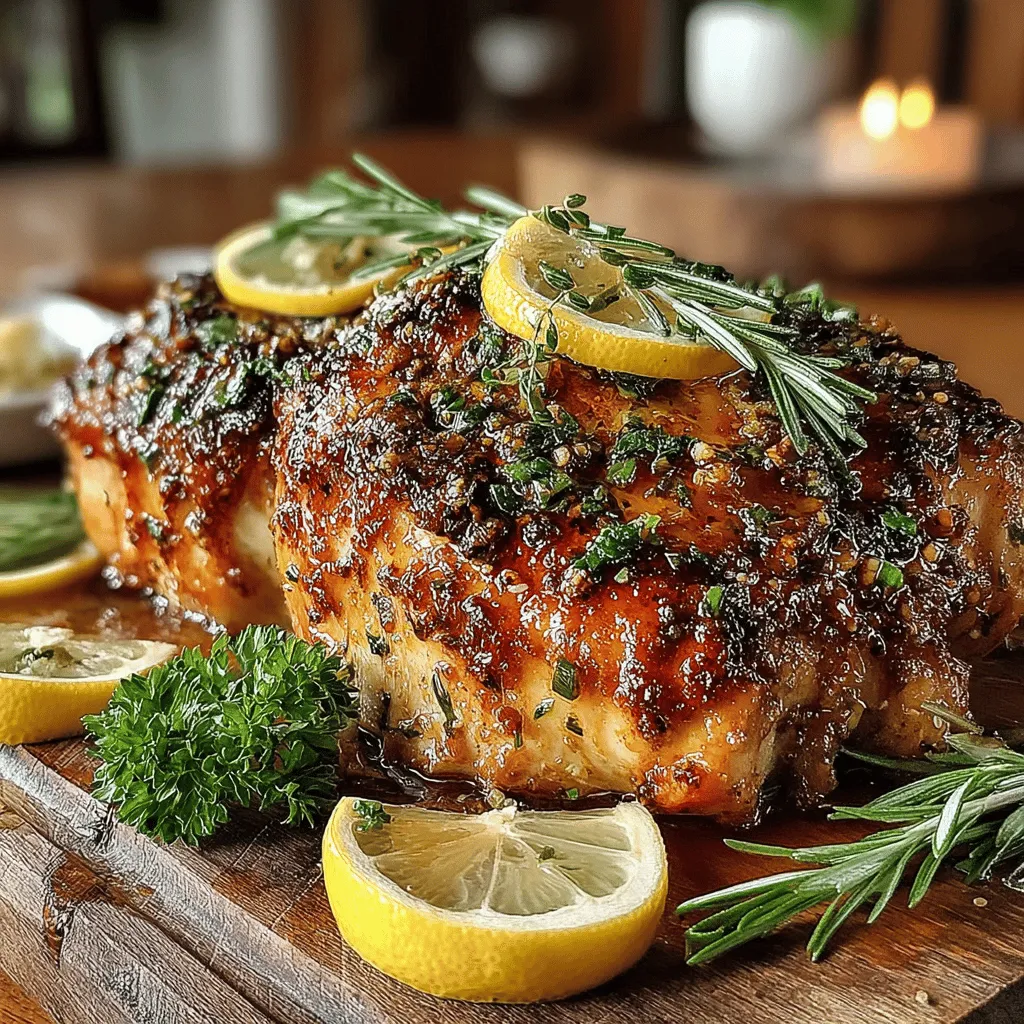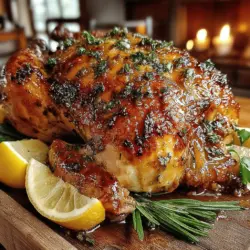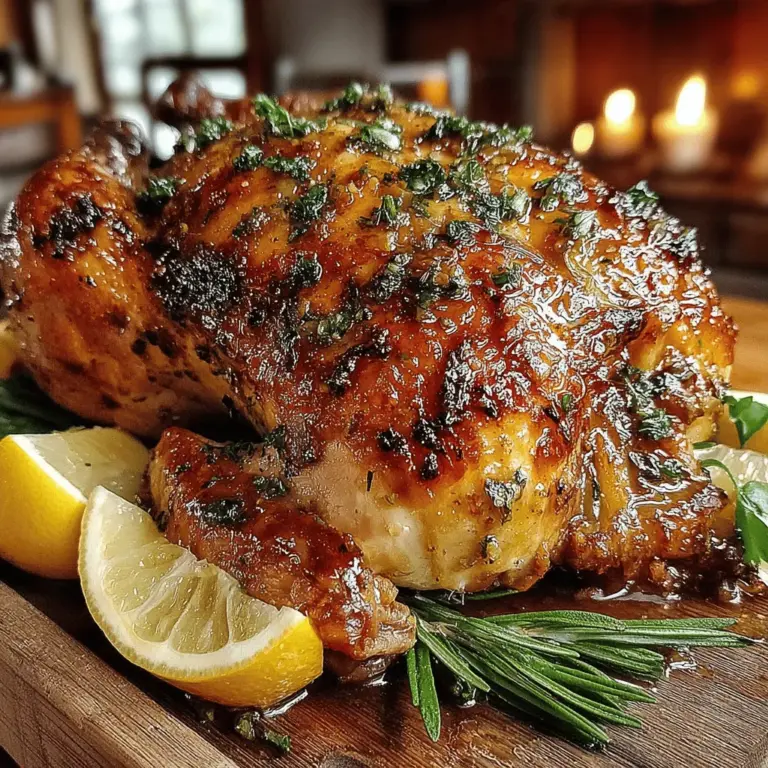Lemon Zest Turkey Delight Recipe
Introduction
Turkey has long been a centerpiece of culinary traditions, especially during festive occasions such as Thanksgiving, Christmas, and family gatherings. Celebrated for its versatility and ability to feed a crowd, turkey has found its way into countless recipes across various cultures. The tradition of roasting turkey dates back centuries, with each region adding its unique spin to this beloved dish. While classic preparation methods often dominate holiday tables, modern cooks are increasingly looking for innovative ways to elevate this traditional bird.
Enter the Lemon Zest Turkey Delight—a refreshing twist on the conventional turkey recipe that infuses vibrant citrus flavors into the meat. This dish not only enhances the natural taste of turkey but also offers a delightful aroma that fills your kitchen, tantalizing the senses. The Lemon Zest Turkey Delight combines zesty lemon, fragrant herbs, and a buttery glaze, creating a memorable meal that is sure to impress your family and friends.
The importance of balancing flavors and utilizing preparation techniques that enhance the turkey’s natural taste cannot be overstated. The addition of citrus, herbs, and spices contributes to a succulent and flavorful turkey that stands out on the dinner table. In this article, we will explore the key ingredients that make this recipe a standout and guide you through the preparation steps to ensure a successful cooking experience.
Understanding the Key Ingredients
To create a Lemon Zest Turkey Delight that dazzles the palate, it’s essential to understand the key ingredients involved in the recipe. Each component plays a vital role in achieving the perfect balance of flavors.
Whole Turkey
The star of the show is, of course, the turkey itself. For this recipe, a whole turkey weighing between 12 to 14 pounds is ideal. When selecting your turkey, look for a fresh bird rather than a frozen one, as the texture and flavor will be superior. Additionally, consider the quality of the turkey; organic or free-range options often have a richer taste and a more ethical sourcing background. Ensure that the turkey is properly thawed if it was previously frozen, and take the time to inspect it for any signs of damage or undesirable odors.
Low-Sodium Chicken Broth
Using low-sodium chicken broth is an essential aspect of this recipe. By opting for a low-sodium version, you can control the saltiness of the dish while still achieving a rich flavor. The broth not only adds moisture to the turkey but also infuses the meat with additional depth. The liquid will be added to the roasting pan, helping to create a flavorful steam that keeps the turkey juicy throughout the cooking process.
Unsalted Butter
Butter is a critical component in creating the flavorful glaze that coats the turkey. Unsalted butter is preferred because it allows for better control over the seasoning of the dish. The richness of the butter enhances the overall taste while contributing to a golden, crispy skin as the turkey roasts. Combining butter with the other ingredients creates a luscious mixture that seeps into the meat, ensuring every bite is delectable.
Fresh Lemon Juice and Zest
The inclusion of fresh lemon juice and zest is what sets this recipe apart, providing a bright and zesty flavor profile. The acidity from the lemon juice helps to tenderize the turkey while the zest adds a concentrated citrus aroma. This combination not only elevates the flavor of the turkey but also helps to balance out the richness of the butter, creating a harmonious dish that is both refreshing and satisfying.
Fresh Herbs (Rosemary and Thyme)
Herbs are integral to enhancing the flavor of the turkey. Fresh rosemary and thyme are the perfect complement to the lemon, adding a fragrant earthiness that rounds out the dish. These herbs not only add depth to the flavor but also contribute to the overall aroma, making your kitchen smell divine as the turkey roasts. When selecting herbs, fresh is always best, as dried herbs can lack the vibrant flavor and fragrance that fresh herbs provide.
Garlic and Onion Powder
Garlic and onion powder are staples in seasoning blends, and they play a crucial role in this recipe. Their savory notes bring additional complexity to the flavor profile, enhancing the turkey’s natural taste. When combined with the lemon and herbs, these powders help create a well-rounded seasoning that permeates the meat during the cooking process.
Sugar
While it may seem unusual to include sugar in a savory turkey recipe, it serves a crucial purpose. Sugar balances the acidity of the lemon juice, creating a more rounded flavor. Additionally, when combined with the butter, it helps to form a beautiful caramelization on the turkey’s skin, adding both color and texture to the finished dish.
Salt and Pepper
Finally, the importance of salt and pepper cannot be overlooked. These basic seasonings are fundamental in enhancing the overall taste of any dish, and turkey is no exception. Salt brings out the flavors of the other ingredients, while pepper adds a subtle heat that elevates the dish. Be sure to season the turkey generously, both inside and out, to ensure a flavorful final product.
Preparation Steps for Lemon Zest Turkey Delight
Now that we’ve explored the key ingredients, it’s time to dive into the preparation steps for creating your Lemon Zest Turkey Delight. Following these steps carefully will help you achieve a perfectly roasted turkey that is bursting with flavor.
Preheating the Oven
The first step in preparing your turkey is to preheat your oven. This is a crucial step that should not be overlooked, as it ensures even cooking and helps to achieve that coveted crispy skin. Aim to preheat your oven to 325°F (163°C). This moderate temperature allows the turkey to cook slowly and evenly, preventing the outside from becoming overcooked while the inside remains underdone.
Preparing the Turkey
Before you can start cooking, it’s essential to prepare the turkey properly. Begin by removing the turkey from its packaging and removing any giblets or neck that may be stored inside the cavity. Rinse the turkey under cold water, being careful to clean both the inside and outside thoroughly. Once rinsed, use paper towels to dry the turkey completely. This step is vital, as excess moisture can lead to steaming rather than roasting, which will result in a less-than-desirable texture.
Making the Lemon Butter Mixture
Next, it’s time to make the lemon butter mixture that will serve as the flavorful glaze for your turkey. In a mixing bowl, combine softened unsalted butter, fresh lemon juice, lemon zest, minced garlic, onion powder, sugar, chopped rosemary, and thyme. Use a fork or a whisk to blend these ingredients together until you achieve a smooth and cohesive mixture. The goal is to create a flavorful glaze that can be easily spread under the turkey’s skin.
Applying the Lemon Glaze
Once the lemon butter mixture is ready, it’s time to apply it to the turkey. Carefully lift the skin from the breast of the turkey using your fingers, being cautious not to tear it. This creates a pocket where you can spread the lemon glaze. Use a spoon or your hands to gently push the lemon butter mixture under the skin, ensuring even coverage. This technique allows the flavors to penetrate the meat, resulting in a juicy and flavorful turkey.
Adding Broth to the Roasting Pan
Before placing the turkey in the oven, don’t forget to add the low-sodium chicken broth to the roasting pan. Pour about one to two cups of broth into the bottom of the pan. This liquid will create steam during the roasting process, ensuring that the turkey remains moist and tender throughout cooking. The broth will also collect the drippings from the turkey, which can be used to make a delicious gravy after the turkey is cooked.
As you can see, the preparation of the Lemon Zest Turkey Delight is both an art and a science. With the right ingredients and techniques, you can elevate a traditional turkey into a refreshing and flavorful centerpiece for any occasion. In the next section, we will delve deeper into the cooking process, including roasting times and tips for achieving the perfect turkey.

Roasting Process
Roasting a turkey is both an art and a science, requiring precision and attention to detail. To achieve the perfect Lemon Zest Turkey Delight, it’s essential to control the temperature effectively and utilize proper basting methods.
Temperature Control
Begin by preheating your oven to 325°F (163°C). This moderate temperature is ideal for roasting turkey, allowing it to cook evenly while retaining moisture. Keep in mind that every oven behaves differently, so using an oven thermometer can help ensure accuracy. Position your turkey on the center rack for optimal heat circulation, which is crucial for even cooking.
Basting Methods
Basting is an important technique in turkey roasting that involves spooning or brushing the bird with its own juices or a prepared glaze. This not only enhances flavor but also contributes to a beautiful, golden-brown skin. Start basting the turkey after the first hour of roasting and repeat every 30 minutes. For additional flavor, consider using a mixture of melted butter, lemon juice, and fresh herbs for basting. This will infuse the turkey with more of that delightful lemon essence.
Glazing for Color
As your turkey approaches the end of its roasting time, applying a glaze can elevate its presentation. A simple glaze can be made by combining honey, fresh lemon juice, and a pinch of salt. Brush this mixture over the turkey during the last 30 minutes of roasting, ensuring that the skin develops a beautiful caramelized color that is visually appealing. This final touch not only enhances the turkey’s appearance but also adds a delightful sweetness that balances the savory flavors.
Resting the Turkey
Once your turkey reaches an internal temperature of 165°F (74°C) at the thickest part of the breast, it’s time to remove it from the oven. However, don’t rush to carve it just yet. Allowing the turkey to rest for at least 20 to 30 minutes is essential. This resting period lets the juices redistribute throughout the meat, resulting in a turkey that is moist and flavorful. Cover the turkey loosely with aluminum foil to keep it warm while it rests.
Cooking Techniques and Tips
Roasting a turkey successfully involves understanding various techniques and timing.
Roasting Techniques
To achieve perfectly roasted turkey, consider the following techniques:
– Spatchcocking: This method involves removing the backbone of the turkey, allowing it to lay flat. This can reduce cooking time and promote even browning.
– Brining: A simple brine of salt, sugar, and water can enhance the turkey’s moisture and flavor. Brine the turkey overnight for best results.
The Role of Basting
Basting should be timed effectively. Begin basting after the first hour of cooking, as this allows the skin to set. For the best flavor and moisture retention, use the juices that accumulate in the roasting pan. Avoid opening the oven door too frequently, as this can lower the oven temperature and extend cooking time.
Checking for Doneness
Using a meat thermometer is the most accurate way to check for doneness. Insert the probe into the thickest part of the breast without touching the bone. The turkey is ready when it reaches an internal temperature of 165°F (74°C). Allowing the turkey to rest will ensure that it reaches the final safe temperature as it carries over.
Managing Oven Temperature and Timing
To achieve that perfect golden-brown exterior, consider using the following oven management techniques:
– Initial High Heat: Start roasting at a higher temperature (around 425°F/218°C) for the first 30 minutes to help the skin crisp up.
– Lower Heat: Reduce the temperature back to 325°F (163°C) for the remainder of the cooking time.
– Rotate the Turkey: If your oven has hot spots, rotate the turkey halfway through cooking to ensure even browning.
Serving Suggestions
Lemon Zest Turkey Delight pairs well with a variety of side dishes that enhance its flavor profile.
Traditional Sides
– Stuffing: A classic stuffing made with bread, sautéed onions, celery, and fresh herbs complements the citrus notes of the turkey beautifully.
– Mashed Potatoes: Creamy mashed potatoes, perhaps with a hint of garlic or lemon zest, create a rich contrast to the turkey.
– Cranberry Sauce: The tartness of homemade cranberry sauce elevates the savory qualities of the turkey, making it a holiday staple.
Fresh Salads and Vegetable Dishes
Incorporating fresh salads or roasted vegetables adds brightness and balance to your meal. Consider serving:
– Mixed Greens: A salad with arugula, spinach, and a lemon vinaigrette can refresh the palate.
– Roasted Brussels Sprouts: Toss Brussels sprouts with olive oil, salt, and pepper, then roast until caramelized. A squeeze of lemon juice right before serving enhances their flavor.
Presentation Ideas
For a festive table setting, consider arranging the turkey on a large platter garnished with fresh herbs, lemon wedges, and seasonal fruits like pomegranate seeds or cranberries. This not only adds color but also invites your guests to admire the dish before it’s carved.
Nutrition Insights
Understanding the nutritional benefits of your dish enhances the overall dining experience.
Nutritional Breakdown
Lemon Zest Turkey Delight is not just delicious; it also offers significant health benefits:
– Lean Protein Source: Turkey is rich in protein, which is essential for muscle repair and growth. A 3-ounce serving contains about 25 grams of protein while being low in fat.
– Low Calorie Count: Turkey meat is lower in calories compared to other meats, making it a great choice for those watching their caloric intake.
Benefits of Fresh Herbs and Lemon
Using fresh herbs and lemon is not only about flavor; they also add nutritional value:
– Lemon: Packed with Vitamin C, lemons bolster your immune system and add a refreshing brightness to the dish.
– Fresh Herbs: Herbs like rosemary and thyme contribute antioxidants and have anti-inflammatory properties.
Serving Sizes and Calorie Considerations
When serving Lemon Zest Turkey Delight, consider portion sizes. A typical serving of turkey is about 3 to 4 ounces. Accompany this with a generous helping of your chosen sides and salad. A well-rounded plate can provide a satisfying meal while staying within healthy caloric limits.
Conclusion
Lemon Zest Turkey Delight is not just a dish; it’s a culinary masterpiece that brings flavor and festivity to any table. With its zesty notes, succulent meat, and appealing presentation, it’s guaranteed to impress your family and friends.
As you prepare this recipe, don’t hesitate to experiment with different flavors and ingredients. Whether you choose to enhance the glaze, adjust the herbs, or switch up the sides, the possibilities are endless. Cooking is a joyful experience, especially when it involves sharing delicious meals with loved ones.
So roll up your sleeves, embrace the process, and enjoy every moment spent in the kitchen. Your Lemon Zest Turkey Delight awaits, ready to create lasting memories around the dining table.


